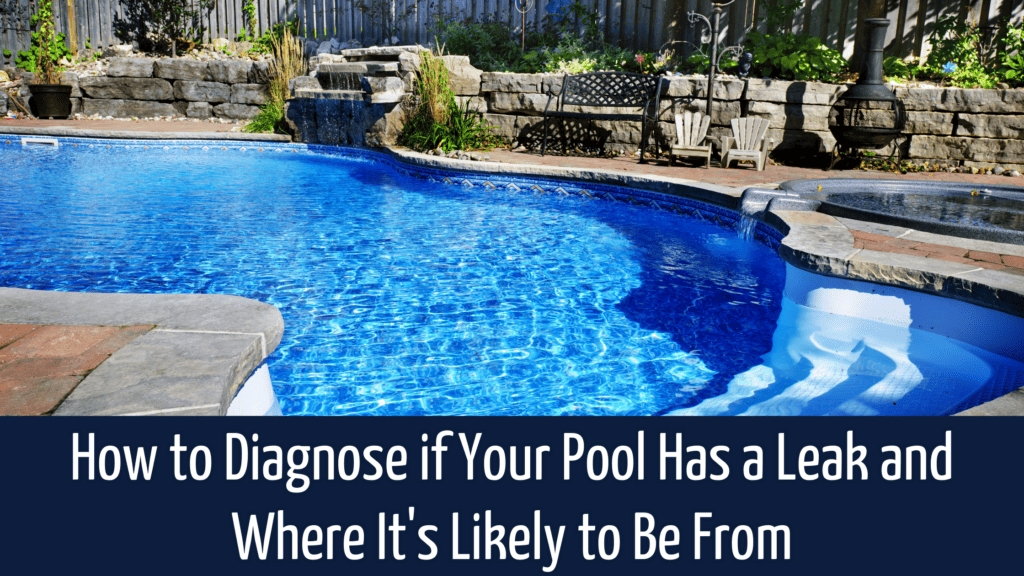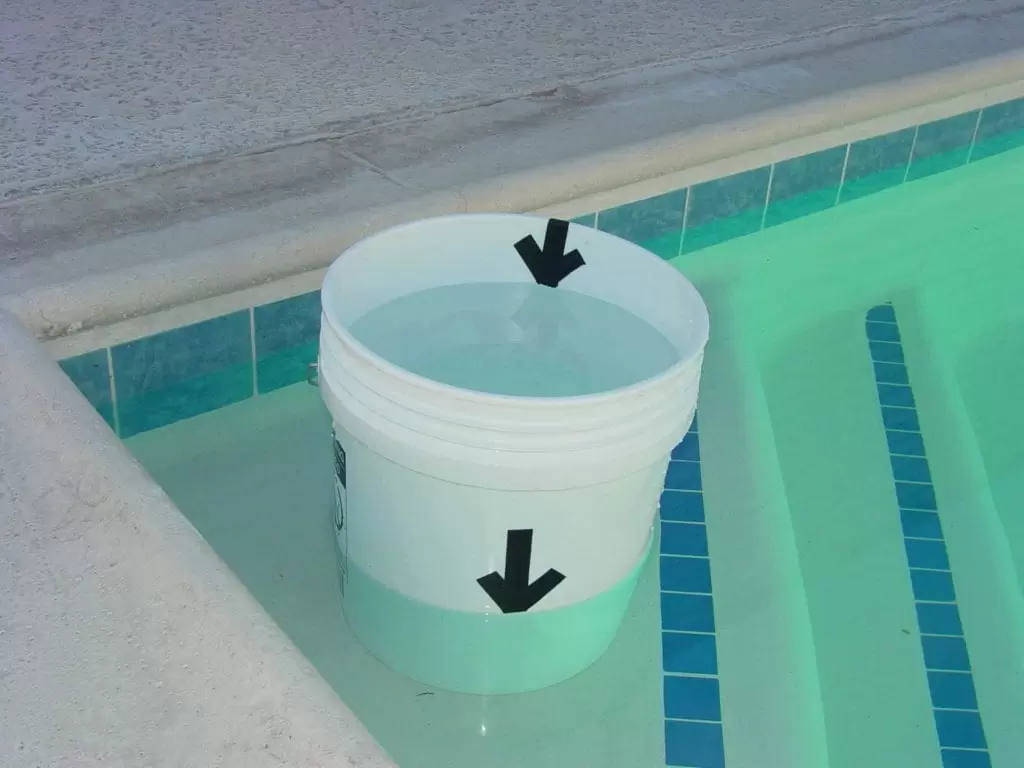We understand that owning a pool is not just about leisure and enjoyment. It also entails responsibility. One of the crucial tasks we often overlook is leak detection.
As your trusted pool service provider, we aim to guide you through the process of identifying and handling pool leaks.
Have you ever noticed your pool losing more water than usual and wondered if it’s due to a leak?

If you have, then you’re not alone. Identifying pool leaks can seem like finding a needle in a haystack, but with some time, patience, and a dash of technical know-how, it can be easier than you think.
You may ask, “Why is identifying a pool leak so important?” The answer is relatively straightforward, Ignoring a pool leak could lead to severe structural damage to your pool, sky-rocketing water bills, and wastage of precious water resources.
It’s not just about keeping your pool at the right level for that refreshing dip on a hot day; it’s also about maintaining your pool’s overall health and longevity.
In this blog post, we’ll guide you through the step-by-step process of identifying a possible leak, determining its location, and suggesting the appropriate remedies.
Pool maintenance may seem daunting initially, but with a little effort and proper guidance, it can become a manageable part of your pool ownership.
So, let’s dive right in!
Understanding the Potential Impact of a Pool Leak
Let’s take a closer look at the potential impacts.
Water Waste
Seeing how a pool leak leads to water waste is not hard. A small leak can result in hundreds or even thousands of gallons of water loss over time.
This is not just bad for your pocket but also detrimental to the environment, especially in areas where water conservation is crucial.
Damage to Pool Structure
A leak can pose a significant threat to the structural integrity of your pool. As water seeps into the surrounding soil, it can cause the ground to shift, leading to a myriad of problems, like cracks in the pool’s shell or a shifting deck.
In severe cases, a leaking pool can cause sinkholes, resulting in costly and extensive repairs.
Increased Water Bills
Like a dripping faucet, a pool leak can also lead to a spike in your water bills. Every droplet that escapes from your pool is a dent in your wallet.
Imagine what a steady stream could do! The financial aspect of a pool leak is often the first thing pool owners notice, turning what was once a refreshing retreat into a money pit.
Understanding these potential impacts underscores why a timely response to pool leaks is so important.
Spotting and addressing a leak early on can save you money and preserve your beloved pool for many summers to come.
Measuring Water Loss
Now, let’s delve into the nitty-gritty of one of the first steps in identifying a potential pool leak – measuring weight loss.
An obvious sign of a leak is when the water level in your pool drops more rapidly than what can be accounted for by evaporation or splash-out. But how do you measure this?
It’s simpler than you might think.
Start by filling your pool to its regular level, marking this initial level. You can do this using a water-resistant market on the pool tiles or simply use a piece of tape.
Over the next 24 hours, avoid using the pool and then measure the change in water level from your mark.
It’s a good practice to do this over several days to get an accurate measure of daily water loss.
It’s important to note that some water loss is normal, especially during hot summer days when evaporation rates are high.
But if you’re losing a quarter inch or more daily, it might be time to dig a little deeper, as this could indicate a leak.
Measuring water loss is a crucial first step in finding out water leakage. By quantifying the rate of water loss, we can start to gauge the severity of the problem.
Is it a minor leak, or are we looking at something more significant?
Remember, the sooner we identify and address a leak, the less damage it can cause to your pool’s structure.
Determining a Leak: The Bucket Test
One of the simplest and most effective tools in our leak detection arsenal is what we in the industry call the “Bucket Test.”

This technique is an excellent way to differentiate between water loss from evaporation and a potential leak.
Let’s take you through this process, step-by-step.
- Fill a Bucket: Take a regular, clean bucket and fill it with water from your pool about two-thirds full.
- Mark the Water Level: Using a marker or a piece of tape, mark the water level inside the bucket.
- Float the Bucket in the Pool: Now, place this bucket on the steps of your pool or somewhere else where it won’t tip over. The bucket must be immersed in the pool but not filled with the pool water.
- Mark the Pool’s Water Level: Similarly, mark the water level on the outside of the bucket, which should be equal to the pool’s water level.
- Wait for 24 Hours: Leave the bucket undisturbed in the pool for 24 hours. Remember not to use the pool during this period.
After 24 hours, compare the water levels inside and outside the bucket.
If the pool’s water level has fallen more than the water level inside the bucket, there’s a good chance you have a leak.
This is because the water inside the bucket is exposed to the same evaporation conditions as the pool but without any possibility of leaking.
If the water levels have dropped the same amount, then it’s likely that your water loss is due to evaporation, not a leak.
This test is an easy and cost-effective method of determining whether your pool might have a leak or if the water loss is a result of evaporation.
Remember, it’s always better to catch a leak early to save yourself from costly repairs and hassle down the line.
If the Bucket Test Proves There’s a Leak
So you’ve completed the bucket test, and it indicates that you might have a leak in your pool.
While feeling a little concerned is natural, there’s no need to panic. Let’s learn what you should do next.
If the bucket test points towards a leak, your pool has decided to share its water with the surrounding environment more than we would like.
However, identifying a leak is only the first half of the challenge. The second half involves finding the exact location of the leak and then fixing it.
This process may require some patience and detective work, but with a systematic approach, it’s entirely doable.
In the next section, we will take you through inspecting the pool filter system, observing water loss when the system is on and off, and investigating potential liner leaks.
Inspecting the Filter System
One of the most common sources of pool leaks is the filter system.
With its network of interconnected parts and mechanisms, there are several potential points where a leak could spring.
Let’s walk you through how to inspect your filter system and identify any issues causing your pool to lose water.
Common Areas Prone to Leaks
Start your inspection by checking the areas most susceptible to leaks.
These include the backwash line, drain plugs, filter belly band, valves, and the plumbing on the return side of the pump.
These components bear the brunt of the pool’s water circulation system, making them prime candidates for wear and tear over time.
How to Inspect
You should conduct this inspection while the pool pump is running.
This is because many leaks in these areas are pressure leaks, meaning they only occur when the pump is on, and water is being circulated.
So, ensure your pump is running as you carry out your investigation.
Look for visible signs of water leakage. This could be water dripping or squirting from the components or a wet area around the filter system that persists even on dry days.
Next Steps if a Leak is Detected
If you notice water coming out from these areas, it’s a clear sign of a leak.
Depending on the severity and the exact location, you can address it yourself with a few spare parts and some elbow grease.
For instance, a leaking drain plug might need to be tightened, while a leaking valve could need a new O-ring.
Remember, always make sure the pump is off before you start making any repairs to ensure safety.
If the source of the leak isn’t clear, or if it appears to be more complex, it’s best to call in a pool professional. In these cases, professional expertise can help fix the problem efficiently, preventing further damage and future leaks.
Your pool’s filter system is crucial in keeping your pool clean and clear.
By routinely inspecting these common problem areas and addressing any leaks promptly, you’re well on your way to maintaining a healthy, leak-free pool.
The Waiting Game: Observing Water Loss
Now that we’ve inspected the filter system, let’s move on to another critical step in our leak detection journey – observing water loss in different states of your pool’s system.
This can provide critical clues about where the leak might be.
Remember, in pool leak detection, patience is a virtue.
Varying Water Loss
Here’s an important point: a pool can lose water at different rates when the pump system is on versus when it’s off.
If you notice more water loss when the system is on, this can be a sign of a pressure-side leak, typically in the return lines that carry water back to the pool after filtering it.
If there’s more water loss when the system is off, it can indicate a suction-side leak, likely in the lines that draw water from the pool to the pump.
Identifying Potential Leak Locations
The level at which water stops decreasing can also offer key insights. If the water stops at the bottom of the skimmer, the leak could be in the suction lines.
If the water stops at the return jets, it could suggest a leak in the return lines.
Isolating Lines for Further Investigation
You can plug certain components, such as the return jets on the steps, to isolate lines and narrow the leak’s location.
Stop the water flow to them at the system, and use plugs designed to seal them off. If the water level remains constant with these jets plugged in, you’ve likely found the area of the leak.
Observing water loss is indeed a waiting game, but it can provide invaluable information to identify the leak’s culprit.
Though time-consuming, this process can save you future headaches, water loss, and expensive repair bills.
Investigating Liner Leaks
Switching gears a bit, let’s focus on another important component of your pool that may be prone to leaks – the liner.
Specifically, this section is critical for those with vinyl liner pools.
If left unchecked, a leak in your liner can lead to severe complications.
Let’s explore how to detect a leak in the liner and the steps you should take.
Signs of a Liner Leak
The signs of a liner leak may not be as apparent as a leak in the filter system or plumbing lines. One telltale sign is when the water goes beneath the level of any returns or lights.
This is because these components are usually embedded in the liner, and if the water level drops below them, it’s likely that the liner may be the culprit.
When a Liner Leak is Suspected
If you suspect a leak in your vinyl liner, it’s essential to act promptly.
Start by visually inspecting the liner, especially around the areas where it’s most vulnerable to wear and tear.
This includes areas around steps, corners, returns, lights, and any place where the liner has been cut or pierced during installation.
Be aware that not all liner leaks are visible to the naked eye. Small pinholes or tears can be elusive and difficult to spot.
Professional Vinyl Liner Leak Detection
A professional inspection can be invaluable in these instances, where the leak may not be easily noticeable.
We utilize specialized leak detection equipment that can accurately locate even the most minor leaks, saving you hours of searching.
Once the leak is located, most liner leaks can be repaired on the spot. This is typically done by patching the liner with a piece of matching liner material and a specially formulated underwater adhesive.
Detecting and addressing liner leaks is a crucial part of maintaining the integrity of your pool.
Whether you can spot the leak yourself or require professional assistance, remember – acting quickly can save you not only water but also potential long-term damage to your pool.
Preventive Measures and Regular Maintenance
While we’ve focused quite a bit on identifying and addressing pool leaks, we must not forget that prevention is always better than cure.
Regular pool checks and maintenance can keep your pool in pristine condition and help you identify potential leaks before they become problematic.
Let’s delve into how consistent pool maintenance is vital in preventing leaks.
The Importance of Regular Pool Checks
Routine pool checks should be part of every pool owner’s schedule.
This means checking your water levels, checking the pool equipment, and visually inspecting your pool’s interior for any signs of wear and tear.
Remember, early detection of a small leak can prevent a more significant, more expensive problem.
Pool Maintenance Tips to Prevent Leaks
There are several preventive measures you can take to avoid leaks.
For instance, maintaining balanced water chemistry can help prevent the deterioration of pool materials.
Regularly cleaning your pool filter and skimmer basket can prevent undue pressure on your pool’s plumbing system.
Furthermore, maintaining the pool area can also help prevent leaks, sharp objects, and heavy activity near the pool can damage the pool’s surface or liner.
Professional Pool Maintenance Services
If you find the task of regular pool maintenance overwhelming, or if you don’t have the time, our professional pool maintenance services can be a lifesaver.
Our team of trained professionals handle everything from routine cleanings and chemical checks to equipment inspections are more, ensuring your pool remains in the best possible shape.
Remember, owning a pool is not just about the fun and relaxation it brings but also about the care and maintenance it requires.
By implementing preventive measures and sticking to a regular maintenance schedule, you can always enjoy your pool in pristine condition.
Leak Detection and Repair
Detecting a leak is just the first part of the equation.
Once we’ve identified the leak, the next step is to address and repair it.
These leaks often need to be found and patched using specialized leak detection equipment.
Finding and Patching Leaks
Specialized leak detection equipment can find leaks that aren’t visible to the naked eye, locating them accurately down to the inch.
Once the leak is detected, the repair process begins.
Depending on the location and severity of the leak, this could involve patching a liner, sealing a crack, replacing a seal, or even addressing plumbing issues.
The aim is to ensure the leak is completely sealed to prevent further water loss.
Our Leak Detection Equipment
When it comes to leak detection, we don’t just use any equipment; we use only the best. Our professional leak detection kit from VILO allows us to pinpoint the exact location of leaks, whether tears, pinholes, or separations in vinyl liners, with absolute precision.
When to Call a Professional
Taking the time to conduct the leakage inspections is commendable. Still, there are instances where you must call in professionals like us.
How can you tell it’s time to bring in the experts? Let’s look at some scenarios.
Inconsistent water loss despite attempted repairs, signs of significant damage to your pool’s structure, or even the recurrence of leaks are some.
Moreover, if you’re struggling to identify the source of a leak despite your best efforts, it might be time to call us.
Call us at (631) 203-1693 to get pool leakage inspected and repaired.
Our team of experts brings a wealth of experience and specialized equipment to quickly locate and repair leaks.
Additionally, regular professional pool maintenance can help prevent future leaks and extend the life of your pool.
Conclusion
As we wrap up this guide, it’s important to understand that detecting and repairing pool leaks is essential in preserving the integrity of your pool.
Timely detection and repair can save you from extensive damage and costly repairs.
We hope this guide has provided a roadmap for detecting pool leaks, understanding their potential impact, and taking steps toward their resolution.
However, always remember that each pool is unique and may require professional expertise to ensure it remains in optimal condition.
If you suspect your pool has a leak or if you want to get your pool checked, please don’t hesitate to reach out by calling us at (631) 203-1693 or clicking the button below.
Our team is always here to help you enjoy your pool without worrying about leaks and damage.


